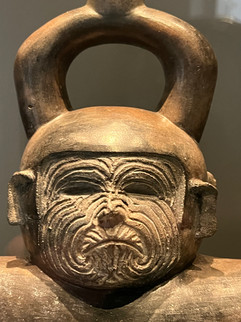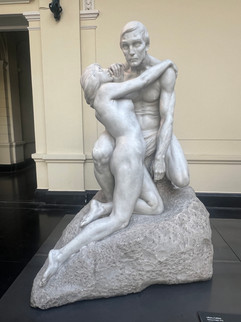Leaving Argentina, I was excited to be heading to Santiago and meeting Zach and Cam. The original plan was to meet Sheri in Santiago, but Zach called and said he wanted to come down to go skiing with me in Chile and Argentina, and bring along his friend Cam. Sheri was kind enough to cancel her flight so that Zach and Cam could come and we would have enough room in the Jeep. I was certainly looking forward to seeing Sheri after our longest time apart (12 weeks), but I was also excited to go skiing with Zach and Cam.
I crossed into Chile via the Paso Internacional Los Libertadores (also called Cristo Redentor), the main highway between Mendoza and Santiago. The border crossing took awhile; it seems that the Chileans are very serious about not allowing fruits, vegetables, seeds, dairy, or meat into Chile. All I had was a red pepper which I gave to them right away, but they proceeded to search the truck thoroughly including with a dog sniffing every corner.
Right after crossing the border, I came to the ski area of Portillo. Portillo is a first-class ski area with a beautiful hotel and surrounded by spectacular Andes peaks. It first opened in 1949, and once hosted the Alpine World Ski Championships in 1966, the year that Jean-Claude Killy emerged. Several national ski teams train at Portillo in August and September. I wandered around the hotel, looking at all the signed photos, and met the mountain manager, a guy from the United States. He told me that the national teams from Norway, Switzerland, and the United States were there training. As I walked out of the hotel, I met some Norwegian ski racers and talked with one of them about their training. He showed me where they do the downhill training. He was very nice (as I would expect from Norwegians). I recognized one of the Norwegians as Aleksander Aamodt Kilde, one of the world's best ski racers at the speed events.
I thought about staying at Portillo and skiing the next day, but decided I needed to get to Santiago and go to the Jeep dealer. I found a nice place to camp in the hills about an hour north of Santiago. It was very dark when I got there, but the next morning I woke up to a beautiful view.
In the morning I drove straight to the Jeep dealer in Santiago to buy new tires and to determine why I continued to get service warnings regarding the ABS and electronic stability control. I left the Jeep with the service center for a couple days and got a hotel in Santiago. The next couple days I got some work done in the hotel and got ready to pick up Zach and Cam at the airport. I stopped at the Jeep dealer after picking up the guys since I was still getting service warnings. While they checked it, the three of us headed to the city center.
Santiago is unlike any other city that I've experienced in South America. It is very modern and cosmopolitan with excellent infrastructure including the roads and metro. The first evening I was in Santiago, I wandered across from my hotel into a mall that was nicer than practically any mall in the United States with brand names from around the world. While waiting for the Jeep, Zach, Cam and I went to the Plaza de Armas and wandered around checking out the architecture. We went to an amazing museum, the Museum of Pre-Columbian Art, with a collection from nearly all of Latin America including some of the nicest pieces that I have seen during our travels. When we returned to Santiago after our skiing road trip, we visited two nice art museums, the Museum of Contemporary Art and Museum of Fine Art. We also visited the sobering Museum of Memory and Human Rights, a museum that commemorates the victims of the military dictatorship of Augusto Pinochet between 1973 and 1990. So sad how most of the countries of South America, especially the southern cone countries, were wrapped up in oppressive dictatorships in the interest of preventing communism during the Cold War, supported in large part by the CIA. We also visited the Mercado Central, where we had a great lunch at a seafood restaraunt. The owner, Sebastion, told us about the Mercado Central with its beautiful cast-iron roof, constructed and shipped from the United Kingdom in 1872.
While in Santiago, we stayed at the Patagonfox campground. It was probably the cleanest, nicest campground that I have stayed at in South America. Being clean, it enabled us to get organized and repack the truck for our skiing road trip. The owner, Cristian is very nice and very helpful, as was the campground manager, Jeremy.
We returned from our skiing road trip on September 30th. We got back a little early, largely because it was raining in Pucon. We thought we might go skiing at Valle Nevado, but the weather wasn't great. So we decided to head to the coast. We visited some coastal towns north of Valparaiso, and got an AirBnB with a wonderful view looking out over the Pacific. The next day we went to Valparaiso. Valparaiso is the second-largest city of Chile and a major seaport. It has also been the headquarters of the Chilean Navy since 1817. It was an important stopover for ships traveling between the Atlantic and Pacific Oceans, and had a golden age in the second half of the 19th century, with many new immigrants. The economy had a downturn in the 20th century after the opening of the Panama Canal, but things are looking up in the last couple decades.
We visited the National Maritime Museum and learned about the interesting naval history of Chile, including the role played in the War Of the Pacific with Peru and Bolivia where Chile gained major territory. We wandered around the city center, checking out the architecture from Valparaiso's golden age. Valparaiso has a bit of artistic and bohemian culture, and is well known for its street art. It would have been nice to have a bit more time in Valparaiso, but we headed back to the campground so that we would have a day to pack for the boys going home, and me heading to Rapa Nui.






































































































































Comments